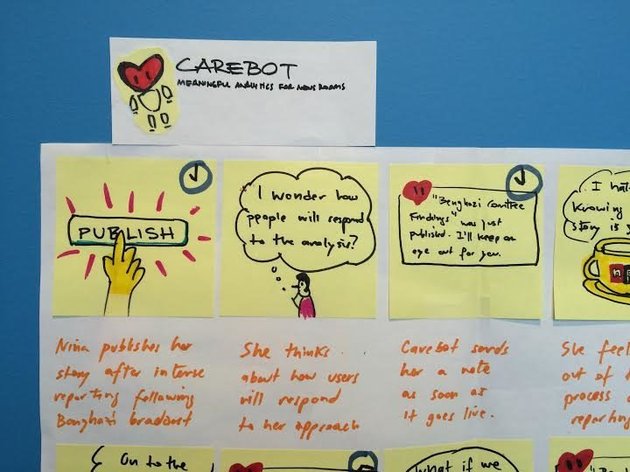
If you work at a digital news organization, you’re likely surrounded by numbers: pageviews, shares, clicks. But how do you move past one-size-fits-all stats (and analytics programs designed more for brands and retailers than journalists) to the numbers you should really care about?
Carebot is a chatbot that wants to help answer that question by letting publishers define their own windows on analytics data, customized to their own needs. Launched in February by NPR’s visual editor Brian Boyer, former Knight-Mozilla Fellow Livia Labate, and LocalData’s Matt Hampel, Carebot’s mission is to provide meaningful journalism analytics that go beyond pageviews, that allow newsrooms to define success on their own terms. With a $35,000 grant from the Knight Foundation’s Prototype Fund, the Carebot prototype was created to help news organizations measuring the less quantifiable value of their work.
“As journalists we ask ourselves, ‘Are we doing our job?'” Boyer said. “Our job is to make our readers care.”Carebot is a prototype of two ideas, Boyer said. The first: “Success means different things to different teams, and the generic ‘top 10 stories, ranked by pageviews’ doesn’t fit everyone’s needs.” The second: “It’s important how we communicate metrics. Carebot was built to help us test the idea of communicating measures of success in a public place where folks hang out — the team chatroom” — in this case, Slack. There are no plans to turn Carebot into a full-fledged analytics system, Boyer said: “It’s more of an experiment in interface design.”
“It’s a valuable experiment in a media landscape that is just starting to rethink the impact of metrics,” said Hampel, who was involved during the prototype phase of the project from February to May. Carebot participated in a Knight-Mozilla OpenNews “code convening,” a design workshop that allowed media organizations like The Texas Tribune to test Carebot out.“Much of what we did [during Code Convening] was figuring out the pain points of migrating it out of the NPR setup,” said Ryan Murphy, a data visualization reporter at the Tribune. Once the bot is integrated into a Slack team like the Tribune’s, users can ask Carebot to provide analytics that your average Google Analytics summary can’t take on.

Carebot aims to cut the clutter of analytics by working with what the user wants directly, but that will take development resources by the news organization in question. “Carebot does not come with a lot built in right now,” Boyer said. “You probably will want to build your own plugins, to report on the metrics that are most important to you. If you’ve got your different teams — the graphics desk, the politics team, etc. — using different Slack rooms, you can give the teams their own sets of metrics.”
“When you publish a story, it knows when you publish and starts recording metrics from that story. You ask it, ‘Hey, how is this story doing?’ It will tell you the metrics that you set and it’s configurable for all teams. It’s pretty minimal” — a “blank slate for everyone.”
Carebot hasn’t attracted many actual users yet. The Texas Tribune hasn’t used it since the code convening, saying they’ve been too busy to integrate it into their regular workflow. Hampel left the Carebot team at the end of the prototype phase, while Labate has taken a sabbatical from the project. The last update to the GitHub repo was in late May.Boyer encourages anyone to try out the product and give feedback: “Contribute, tell us if it’s useful.” As of now, there are no plans to monetize. “What are we gonna do, sell this thing? Maybe if we got venture capital. But having better analytics is better for all of us.”